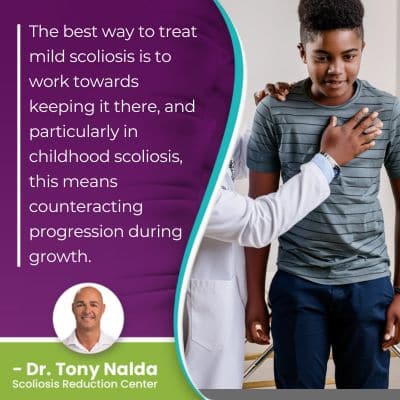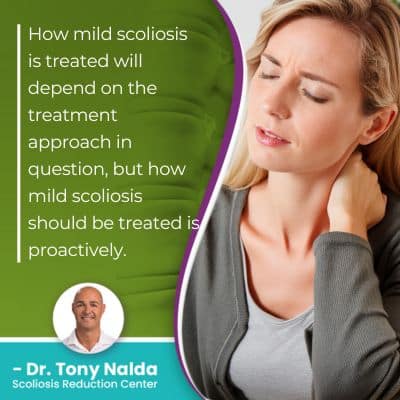How Do You Treat Mild Scoliosis? [What You Need To Know]

There are no treatment guarantees, but when a proactive treatment approach is applied that works towards preventing progression and increasing condition effects, there are fewer limits to what can be achieved. Scoliosis is progressive and incurable, but it can be highly treatable, particularly when mild.
Mild scoliosis is unlikely to stay mild without the help of a proactive treatment approach. It's best to start treatment while scoliosis is mild because smaller curves are simpler to treat than larger curves, and conservative treatment offers a proactive treatment response with proven results.
How you should treat mild scoliosis is proactively, so let's start with the different treatment options patients have to choose between.
Table of Contents
Scoliosis Treatment Options
Once a patient is diagnosed with scoliosis, the most important decision to be made is how to treat the condition moving forward, and as an incurable progressive condition whose nature is to get worse over time, how a diagnosis is responded to with treatment is key.
How scoliosis is treated will shape the spine's long-term spinal health and function; scoliosis involves the development of an abnormal curvature of the spine that also rotates, making it a complex 3-dimensional condition.
Scoliosis progression is triggered by growth, which is why childhood scoliosis should always be taken seriously, and a proactive treatment approach will work towards counteracting the condition's progressive nature.
There are also multiple different types of scoliosis a person can develop, and scoliosis affects all ages from babies born with the condition because of the spine not forming properly, to infants, juveniles, and the most prevalent type overall: adolescent idiopathic scoliosis, diagnosed between the ages of 10 and 18; adult scoliosis is diagnosed once skeletal maturity has been reached.
Most cases of scoliosis are idiopathic (80 percent), meaning cause unknown, and the remaining 20 percent are associated with known causes: neuromuscular scoliosis, congenital scoliosis, and degenerative scoliosis.
Patients can choose between traditional scoliosis treatment and modern conservative treatment; traditional scoliosis treatment is reactive, while conservative treatments are proactive.
In fact, traditional scoliosis treatment commonly responds to a diagnosis of mild scoliosis with the recommendation to merely watch and wait because they don't have a strategy for addressing scoliosis while mild.
Conservative treatment looks at a diagnosis of mild scoliosis as an opportunity to start impacting the condition when it's most likely to be responsive: while mild.
The Benefit of Proactive Treatment
The best time to start treatment for all severity levels of scoliosis is now because when it comes to progression, this means the size of the unnatural spinal curve is increasing in size, as are the condition's uneven forces, and their effects.
As a scoliotic curve increases in size, the spine gets increasingly rigid, making it less responsive to treatment, and increasing spinal rigidity can also make it difficult for some patients to perform key therapeutic exercises as part of treatment.
In fact, in some cases, particularly those involving adults who have progressed a significant amount prior to starting treatment, some preparatory work has to be done first to establish a baseline level of spinal flexibility
So as you can already see, there are a number of benefits to starting scoliosis treatment while mild, but in order for that to happen, conditions first have to be diagnosed while mild, and this isn't always easy.
Mild scoliosis isn't commonly painful for children, isn't associated with functional deficits, and the postural changes it causes can be subtle at this level.
Scoliosis ranges in severity from mild to moderate and severe to very severe scoliosis, and the benefit of proactive treatment is that it can counteract the condition's progressive trigger: growth.
Mild Scoliosis and Progression
 When scoliosis isn't idiopathic and has a known cause, such as neuromuscular scoliosis that's caused by the presence of a larger underlying condition, the larger condition has to be the focus of treatment, so complicates the process.
When scoliosis isn't idiopathic and has a known cause, such as neuromuscular scoliosis that's caused by the presence of a larger underlying condition, the larger condition has to be the focus of treatment, so complicates the process.
As a progressive condition that's triggered by growth, adolescents are the most at risk for rapid-phase progression because of the rapid and unpredictable growth spurts of puberty.
Those undergoing traditional treatment who aren't actively treating their mild scoliosis in favor of a reactive wait-and-see approach are wasting valuable treatment time; conditions can be progressing rapidly in between assessments due to growth spurts, and this makes them more complex to treat.
If mild scoliosis is left untreated and progresses to severe, traditional treatment commonly recommends spinal fusion surgery to stop continued curve progression, but this is a costly, invasive, and risky procedure that should be considered carefully.
And what would have happened if treatment had been applied earlier? It's entirely possible that that level of progression could have been prevented, along with facing the risks of surgery.
While spinal fusion can straighten a bent spine, a fused spine doesn't always come out stronger; in fact, the spine's function can be permanently altered for those experiencing a noticeable loss in range of motion and spinal flexibility.
The best way to treat mild scoliosis is to work towards keeping it there, and particularly in childhood scoliosis, this means counteracting progression during growth.
Chiropractic Care
Scoliosis is a structural condition, so it has to be primarily impacted on a structural level for corrective results, and conservative treatment works towards this through condition-specific chiropractic care: a variety of techniques and manual adjustments that can realign the spine.
The goal of treating mild scoliosis is to keep it that way, to prevent it from becoming moderate scoliosis, severe or very severe scoliosis; the goal is to spare patients the hardships associated with progression and increasing condition effects, and most of all, the need for invasive surgical treatment in the future.
Chiropractic care can help keep the spine strong, flexible, and aligned, but the complex nature of scoliosis does fall beyond the scope of general chiropractic, requiring the skills and training of a scoliosis-specific chiropractor.
Physical Therapy
Physical therapy and scoliosis-specific exercise can work towards increasing the strength of the back muscles so they can provide the spine with optimal support and stabilization.
Increasing core muscle strength means there is less pressure on the spine to maintain its curves and alignment as it's being helped by strong surrounding muscles, and as a muscular imbalance is a common effect of scoliosis, physical therapy can also help keep the muscles that surround the spine balanced.
Physical therapy can also help improve posture, body positioning, and certain scoliosis-specific exercises (SSEs) are known to activate specific areas of the brain for improved brain-body communication.
Corrective Bracing
 Corrective bracing is particularly effective on growing spines so is a regular facet of treatment for childhood scoliosis, and here at the Scoliosis Reduction Center, the ultra-corrective ScoliBrace is my brace of choice.
Corrective bracing is particularly effective on growing spines so is a regular facet of treatment for childhood scoliosis, and here at the Scoliosis Reduction Center, the ultra-corrective ScoliBrace is my brace of choice.
Wearing a brace can help augment corrective treatment results by pushing the spine into a corrective position.
Rehabilitation
Rehabilitation can involve continued chiropractic care and a series of custom-prescribed home exercises to further heal and stabilize the spine.
Lifestyle guidance is another part of rehabilitation; patients need to find a balance of healthy scoliosis-friendly activity levels, and knowing the types of activities, sports, and exercises that are considered safe, which should be approached with caution, or completely avoided is important.
Conclusion
How mild scoliosis is treated will depend on the treatment approach in question, but how mild scoliosis should be treated is proactively.
Traditional treatment commonly recommends watching and waiting with a diagnosis of mild scoliosis, while conservative treatment is started as close to the time of diagnosis as possible.
There are never treatment guarantees, but with early detection and intervention, there are fewer limits to what can be achieved with treatment.
Mild scoliosis symptoms can be subtle and difficult to notice, except for an expert trained in the condition's early telltale signs: uneven shoulders and hips.
If left untreated, mild scoliosis cases are likely to progress and become moderate, and if still left untreated, they can become severe or very severe scoliosis, and once skeletal maturity is reached, scoliosis becomes a compressive condition, which is why the main sign of scoliosis in adults is pain.
Scoliosis pain can include muscle pain, back pain, and pain that radiates into the extremities due to nerve compression.
Uneven pressure caused by scoliosis increases as the condition progresses, so the best way to minimize the condition's effects is to treat it proactively.
In many cases, it's more productive to proactively work towards preventing progression and increasing effects than it is to attempt to work towards reversing those effects once they're established.
Here at the Center, I see a diagnosis of mild scoliosis as an opportunity to keep the condition where it is, to prevent it from getting worse, and I work towards this through an integrative approach combining multiple forms of corrective treatment.
Dr. Tony Nalda
DOCTOR OF CHIROPRACTIC
After receiving an undergraduate degree in psychology and his Doctorate of Chiropractic from Life University, Dr. Nalda settled in Celebration, Florida and proceeded to build one of Central Florida’s most successful chiropractic clinics.
His experience with patients suffering from scoliosis, and the confusion and frustration they faced, led him to seek a specialty in scoliosis care. In 2006 he completed his Intensive Care Certification from CLEAR Institute, a leading scoliosis educational and certification center.
About Dr. Tony Nalda
 Ready to explore scoliosis treatment? Contact Us Now
Ready to explore scoliosis treatment? Contact Us Now





